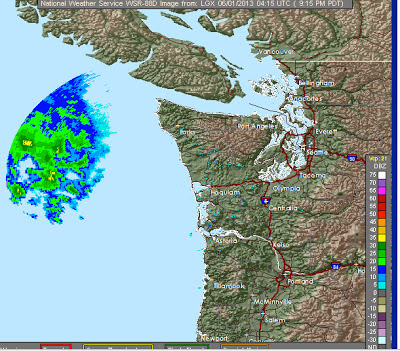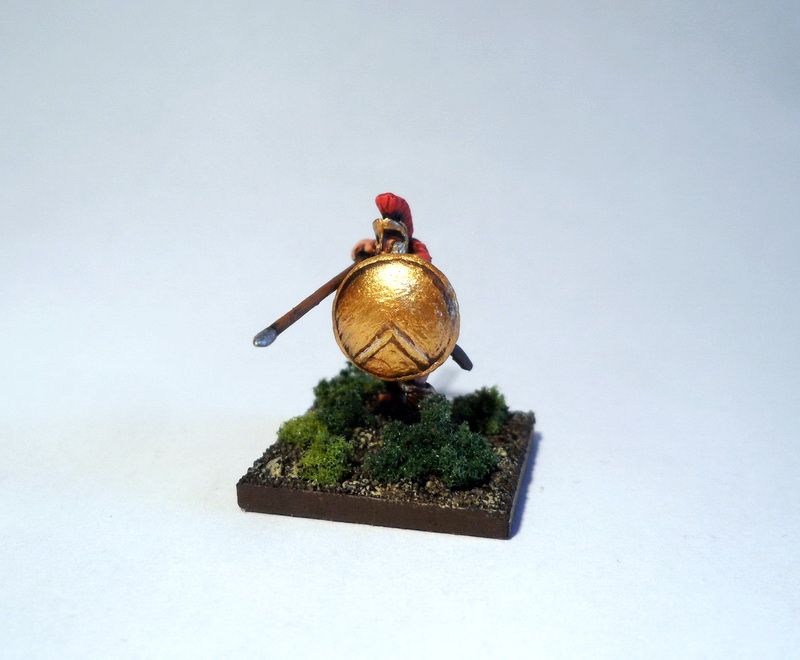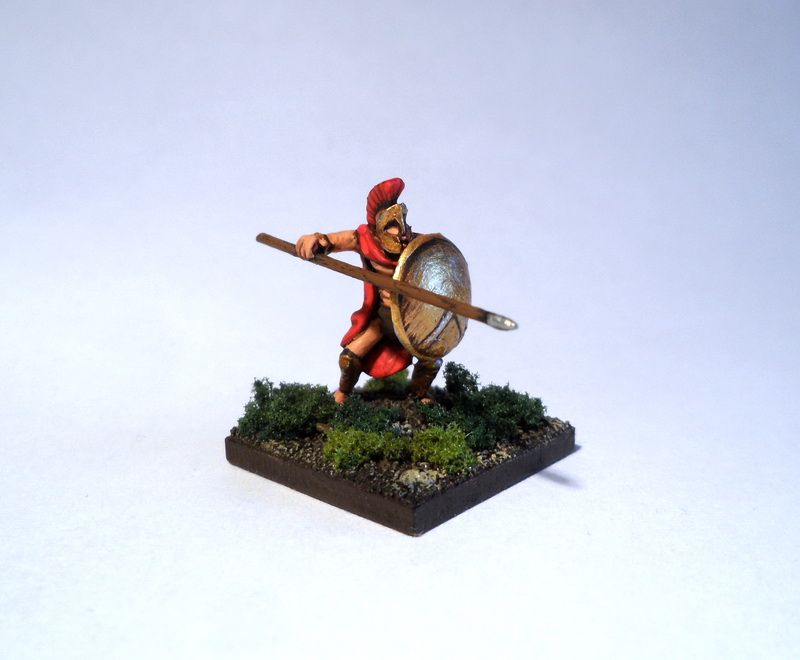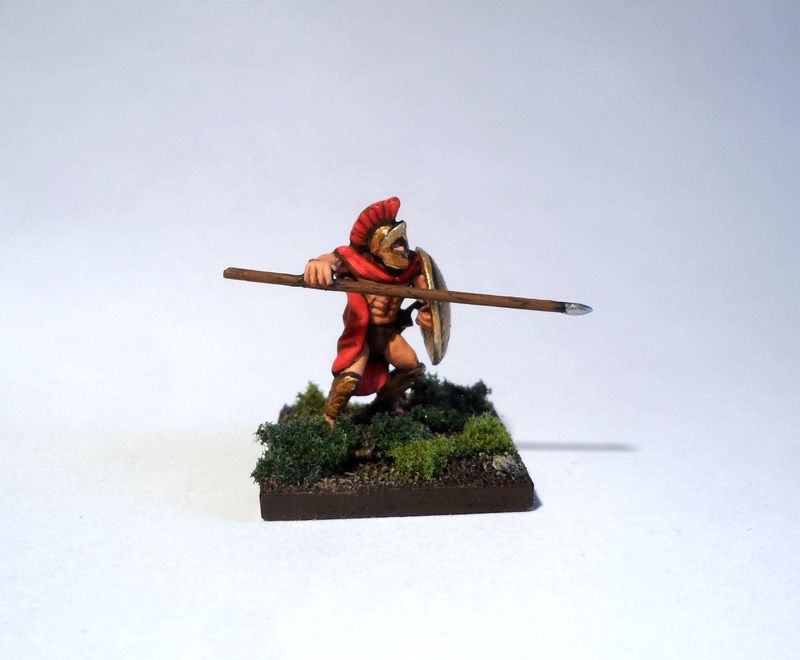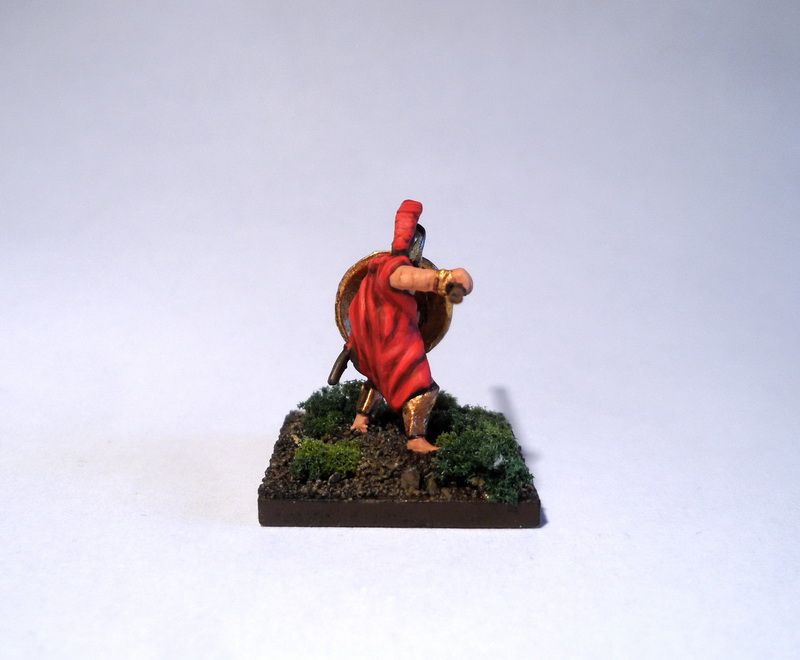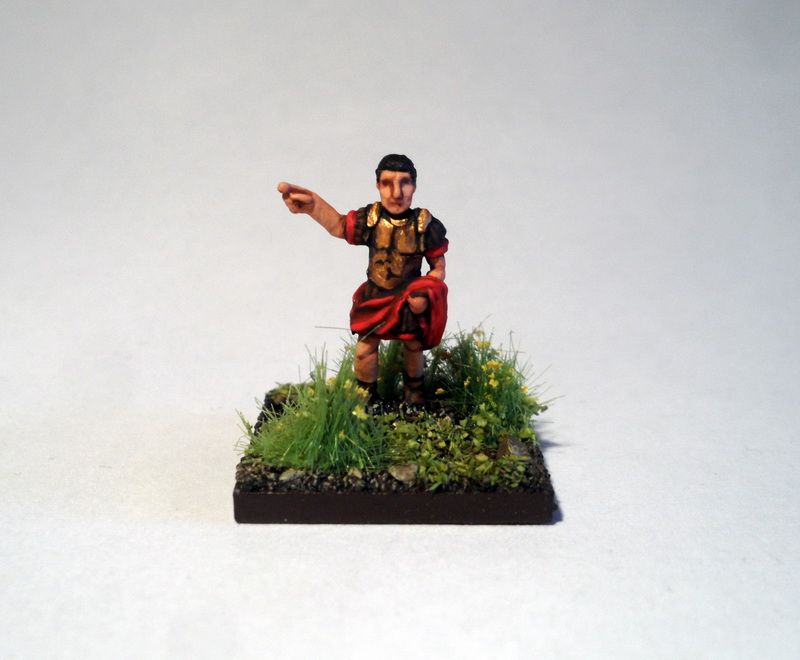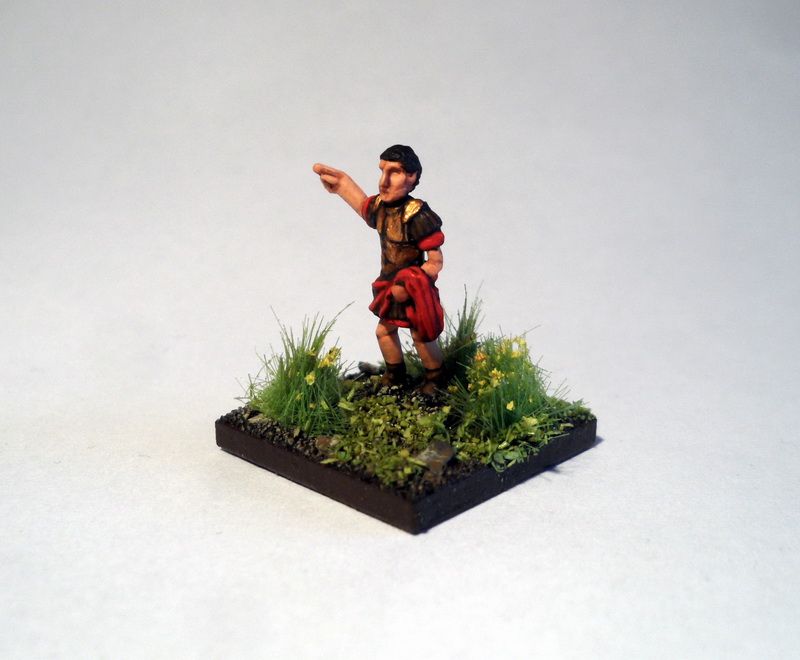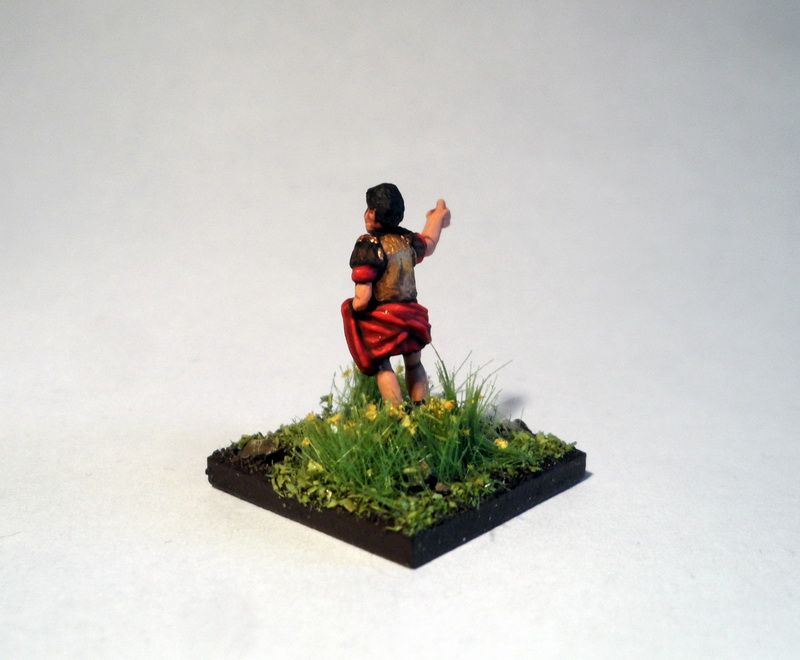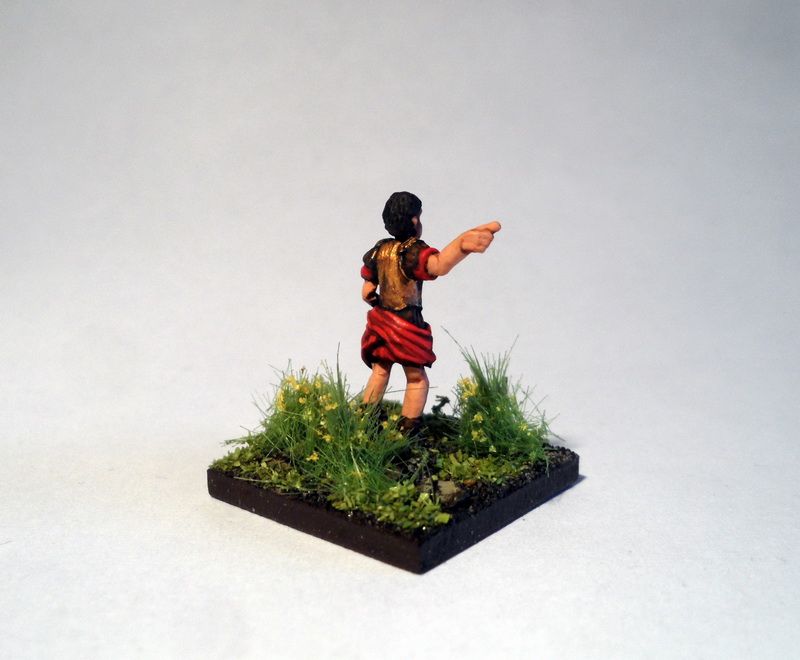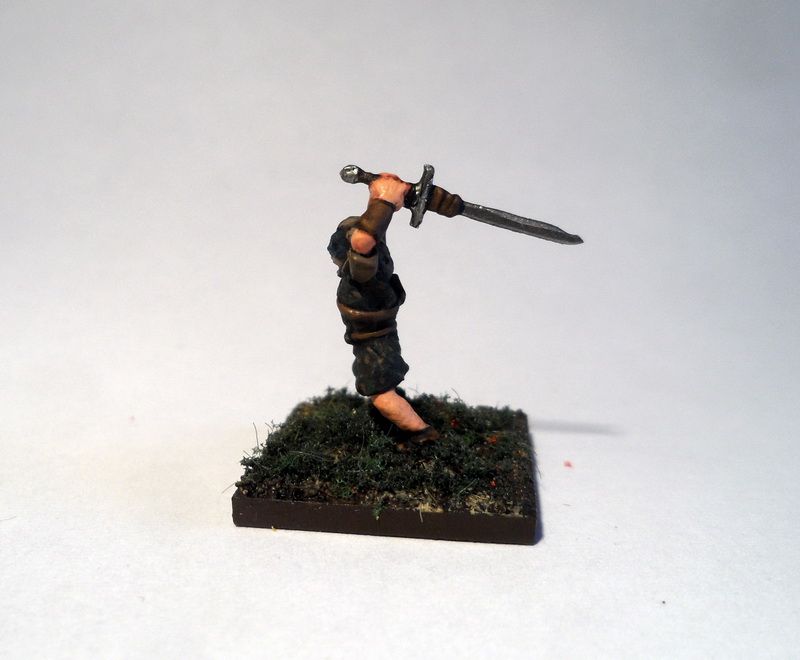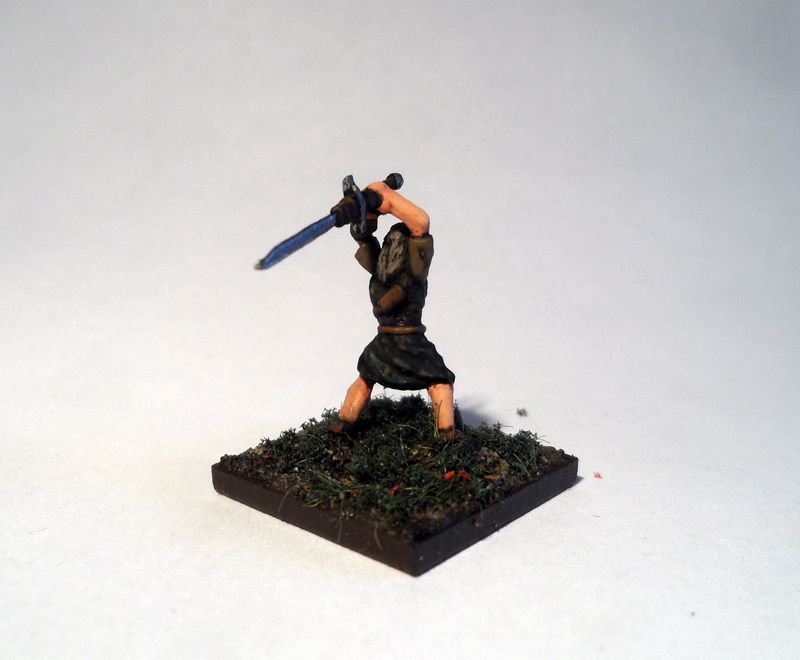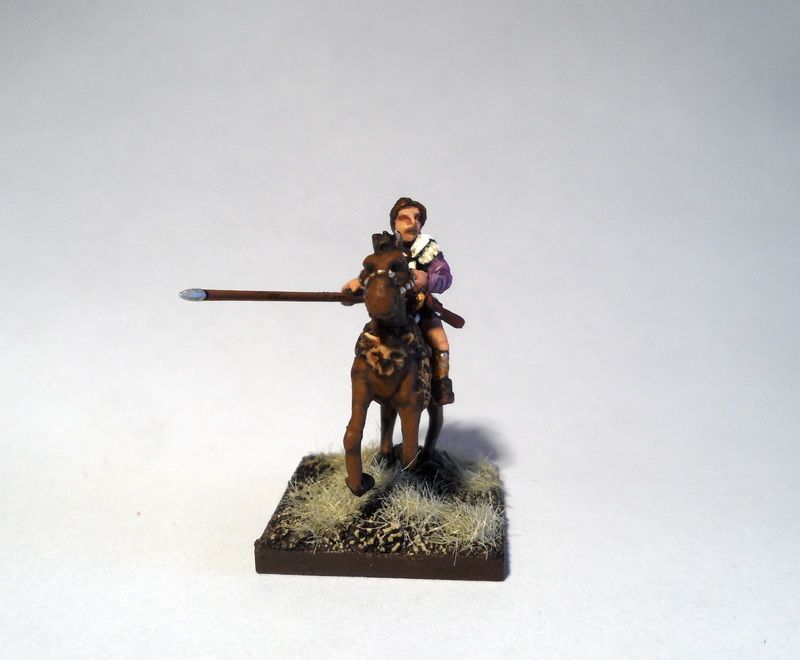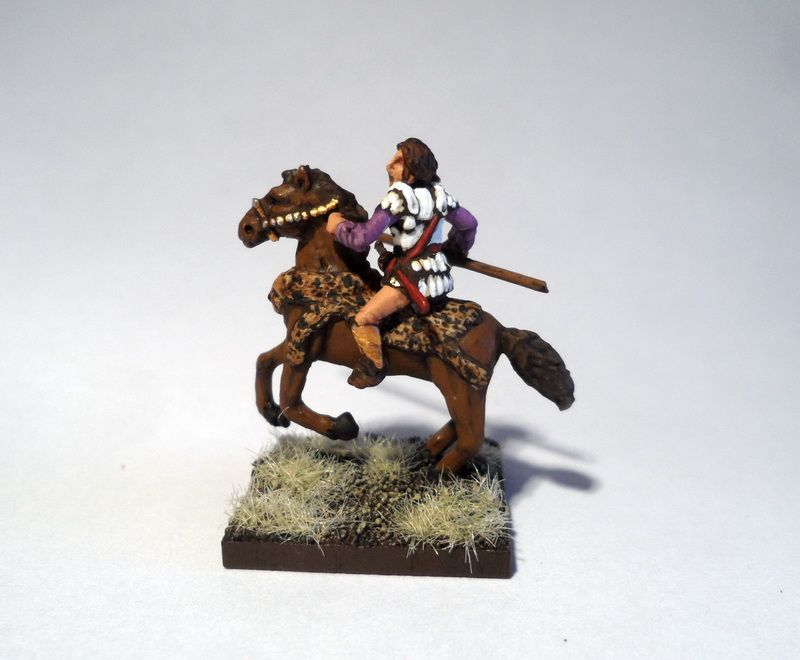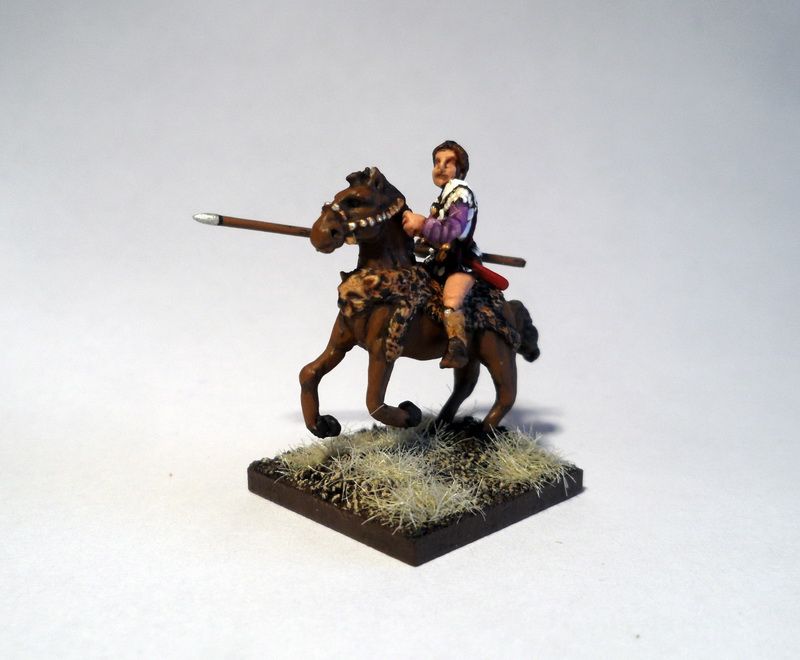Sometimes having a boat (or getting a ride on one) is the ticket for getting some sun, and that approach is often useful in the spring here in the Northwest. The spring is the time of maximum instability of our atmosphere, the time when we see the most convective cloud and showers. The reason is clear: spring is when we have the maximum change in temperature with height. The atmosphere is still fairly cool, while the sun is near maximum strength and thus can effectively warm the surface. When the temperature change with height gets large enough, the atmosphere starts percolating (or convecting), with the upward moving air producing cumulus clouds.
Since the water does not warm quickly, there is little of this cumulus activity over local water bodies. Today's MODIS satellite imagery shows this very clearly. The picture above shows the 1-km resolution image from MODIS (the Aqua satellite), lots of clouds (cumulus) over land, but little over the Strait and the Pacific coast. You will notice a thin strip of the coast is clear; that is the zone influenced by the cool air over the Pacific at low levels.
Here is an even higher-resolution view (250-m resolution). Clouds tend to form preferentially over the higher terrain, and valley bottoms are often relatively clear. If you look closely, you will see some clouds forming over some of the bigger islands such as Whidbey and Orcas.
A weak frontal system is now approaching our coast...the Langley radar near Hoquiam shows it for offshore at 9:40 PM Friday night: We will see increasing clouds from this system Saturday morning and light rain should be generally limited to the northwest portion of the State. The situation should improve later Saturday as this feature moves eastward. Generally dry weekend for most.
Friday, May 31, 2013
Aftershocks
Usually our little genre slumbers in peace, as far as the entertainment media is concerned. The general attitude is: old demos, old shows, zzzzzzzzz. But then something happens - hm, that's a good title for a blog entry - and the media bestir themselves and take at least a little notice.
Autumn Erhard's million-dollar win on Wheel of Fortune has set off a small alarm clock for media types, and a wave of stories has washed over Google News. The account from ABC offers some nice quotes from Autumn:
No one could believe it! They [her parents and fiancé] were just off stage and couldn't see what my prize was. They were celebrating the fact that I solved the puzzle. They kept asking me how much I won, and I had to keep repeating it because no one believed me at first.A grace note is that Autumn and her fiancé can really use the money because he's in construction, an industry that has seen better days. But most anybody can use a million bucks, even after the taxman visits. Congratulations to the big winner.
Penguins vs. Bruins: Tale of the Tape
By GTOG Staff
[You can find the preview podcast here]
It's Eastern Conference Finals Eve, Boston vs. Pittsburgh, when thoughts of Mario Lemieux torturing Ray Bourque swirl in our heads, somewhere Andy Moog is waking up in a cold sweat, and the Tale of the Tape between these two titans becomes urgent and required reading. Our thoughts and prayers are with Ulf Samuelsson's right thigh, which is to this day still traumatized by Cam Neely's carelessness. And we wish Vladimir Ruzicka the best in his quest to forget everything that happened after his 5-point performance in Game 2 in 1991. Let's break this down.
Obstacle Overcomability
This is always our most important category, because it defines the NHL playoffs. If you can play, you can play, but if you can't overcome adversity, you can't win. The Bruins had that historic comeback against the Leafs when they were down three goals in the third period of Game 7, and down two goals with 1:22 left in regulation. Amazing, unprecedented stuff from the Bruins. But you know what else is amazing? The fact that the Toronto Maple Leafs took a 4-1 lead in Game 7 against Boston in Boston. You don't give Bill Clinton credit for still being married to Hillary because no one gets obstacle overcomeability points for overcoming themselves.
The Penguins saw Marc-Andre Fleury - arguably their most important piece of the playoff puzzle heading into round 1 - melt down against the Islanders. They're still meshing as team and figuring out who belongs in the lineup. Their captain and best player is only now setting aside a face shield that - believe it or not - limited his effectiveness. They face enormous external pressure to win and win going away. And all the Penguins are doing is getting better.
EDGE: Pens.
Read on for the rest of the categories ...
Emergeability
The bad news for the Pens is that this is one Tale of the Tape category that they can never win, at least as currently constituted. Unless like 8 guys get hurt, we're not seeing anyone play whose ceiling we don't already know, or at least have a pretty good idea.
Torey Krug redefined emergeability in the Bruins' series, scoring 4 goals in 5 games. But it may not even be the right kind of emergeability. Claude Giroux showed great emergeability in 2008-09 against the Pens, then blew the doors off emergeability in '09-'10 when the Flyers went to the Cup. That was the right kind of emergeability -- he emerged into a much better player than anyone thought he was. What Krug did was so unexpected that it raises the question: was this emergeability or flashinthepanability? Regardless, the Bruins may use three rookie defensemen at any point in this series. Pretty sure everyone on the Pens has been in the league for a dozen years.
EDGE: Bruins.
Coiffability
Hair is about appearance, but it's also about trust. And if you can't trust your captain's hair, how can you trust your captain?
Here's Bruins' captain Zdeno Chara winning the Stanley Cup.
He looks like any other 6'9" man struggling with hair loss, probably figuring that no one will see the top of his head. But here he is at the parade a few days later.
Are we really supposed to believe that it's natural for a 30+ year-old-man to magically patch-up his male pattern baldness in a few days? Get real.
Zdeno made a deal with the devil to win that Cup. Now the debt has come due.
EDGE: Pens.
Sex Appealability
Time to check in with the Women of GTOG for their thoughts on this always crucial factor.
Mrs. Artistry: Edge, Penguins.
Artistry's Mom: Edge, Penguins.
EDGE: Pens.
Legacyability
This is a forward looking category -- think 10 or 15 years in the future and ask yourself whose legacy is more positively or negatively impacted by winning or losing this series.
In the upside department, the Pens have more to gain, if only because they have two players who will be far more memorable than anyone on the Bruins. If the Pens go on to win the Cup, Crosby and Malkin each get a second Cup and become, without any further question, the two defining players of the salary cap era, which would instantly come to be known as the Sid and Geno Era. And because of their popularity and excellence, the Penguins become the defining post-lockout team. Fair or not, that's how life works. If Boston wins, then they can make a better argument for having the best team post-lockout, though there will still be plenty of other teams making a case in what would be an ongoing debate. From an individual perspective, outside of Chara, the Bruins aren't really defined as individuals -- if they win the Cup, they'll basically have 6 or 7 guys who will be remembered like Patrick Elias is remembered. (I mean that as a compliment).
If the Pens lose, it won't put any sort of choker label on them, but it will be devastating. A total wasted opportunity. And if the Bruins lose, does their 2011 Stanley Cup deserve an asterisk because they didn't have to go through Crosby and Malkin to get there?
All of this is a long way of saying that it will be awesome if the Pens win so that we can make fun of the Bruins' Cup in 2011.
EDGE: Pens.
Spurnability
We've made our thoughts on Jaromir Jagr clear this week, but to summarize: we're basically out of thoughts on Jagr. It is the classic it-is-what-it-is situation. He didn't want to play for the Pens last year. We're over it.
Iginla's spurning of Boston is much fresher, though unlike Jagr and unlike Marian Hossa in 2008, the Bruins never really had Iginla. They wanted him; he wanted someone else. There's a big difference between your rival stealing away a girl you just met at the bar and stealing away your girlfriend.
Nevertheless, this will be made into a story all while being downplayed by the Bruins' players. If Boston loses the series, they will continue to downplay it. But if they win? Boy, did we show him!
EDGE: Bruins.
Annoyability
The Islanders were annoying in the way that it's annoying to play pickup basketball against a guy who hustles and sets a lot of screens. He's not doing anything wrong, but who wants the hassle? The only annoying thing the Senators did was make you feel guilty for beating them so badly.
The Bruins are a whole different animal in this department. Brad Marchand and Milan Lucic are this year's Wayne Simmonds and Scott Hartnell -- you want to laugh at them like you do to a Chris Neil, but they're actually good players. Nathan Horton's face when he scores is Cammalleri-esque. Gregory Campbell's dad works for the NHL -- not his fault, but also not our fault for hating him. Pierre McGuire will verbally fellate Patricie Bergeron the first time he makes a good defensive play on Crosby. Tyler Seguin has 1 goal in 12 games, so he will probably score a hat trick Game 1, and then you'll read stories about him being part of the Phil Kessel trade and then you'll be like, "I'm already disgusted and now I'm being forced to read about Phil Kessel?" David Krejci is going to make some sick pass that embarrasses Matt Niskanen, and then McGuire will scream, "KREJCI'S IN HIS HEAD, DOC! DAVY KREJCI IS IN MATTY NISKANEN'S HEAD, DOC!" Jaromir Jagr will make a diving motion at Crosby while we furiously Google "Paul Pierce wheelchair." And you know at least one of their rookie defensemen is going to goad Evgeni Malkin into a bad penalty.
The Pens have their share of annoying tendencies, but there's a huge difference between the two teams. The Bruins can win by getting under your skin. The Pens can get under your skin by winning.
EDGE: Bruins.
Stalwartability
Dejan Kovacevic wrote about the Letang-Chara "match-up" the other day and figured that whoever outplayed the other one would win the series. But in reality, it's not quite that simple. Letang doesn't need to outperform Chara -- he needs to prove that he can do for the Pens what Chara can do for Boston. As great of a player as Letang is and can be, he hasn't anchored a defense to a Stanley Cup the way Chara did for Boston in 2011. When the Pens won the Cup in 2009, Letang averaged 19:18 of ice time per game in the playoffs, the fifth most among Pens' defensemen, and finished with a +1 rating. When the Bruins won the Cup in 2011, Chara averaged 27:39 per game and was a +16.
This isn't to say that Letang can't do it, just that he hasn't. Yet. So far this post-season, Letang is averaing 27 minutes per game and could realistically end up leading the playoffs in scoring by the time it's over. He's been that good. But it also isn't getting any easier.
Chara isn't a target for Letang to beat. He's a measuring stick.
EDGE: Bruins.
Leadability
I like to look at life as a fraternity. Right now the fraternity is me, Tom, Drew, Aar, Joe, Eli, and Pey. I see a lot of that fraternity within these teams. You got Sid, who I'm close with, I feel comfortable just saying to him, 'hey, you know, Sid, if you ever need to shoot some ideas around or pick my brain, me and Ash will have you over any time.' Geno, too. Now they bring in Brend' and 'Rome. Boston is full of great leaders, too. It started with John. Then you had John Quincy. Bill. Larry. Now Tom. I look at their team and I see Looch and March and Kre and 'Deno and it looks a lot like a brotherhood to me. So I just keep doing what I'm doing, controlling what I'm controlling, whether it's going 8-8 with the dink-n-dunk or winning 2 Super Bowls with me throwing deep to 'Twan, 'Tone, and 'Tonio. You know, whatever the team needs. And I see a lot of myself in Sid. This one's for 'Rome.
EDGE: Pens.
Intangibility
This category is less about the more commonly discussed intangibles like leadership, toughness, want-to, really-want-do, sorta-want-to, and definitely-want-to than it is about the ultimate intangible -- whether the invisible hand of destiny will decide to intervene. The Pens don't really have anything in this department; for Boston, the question is whether the whole Boston Strong movement in the wake of the marathon bombings is going to be an emotional factor in this series. It's hard to imagine that it's still going to be, given the amount of tributes, anthems, Sweet Carolines, and all of the other sports-related ceremonies and memorials that have been done already and, of course, the fact that the Pens have already played there in the immediate aftermath (and won). If anything, the emotional toll and the toll on convenience from the manhunt was a negative for Boston: they closed the regular season by going 2-5 and then nearly (and probably should have) lost to Toronto. Now things have returned to normal and the Bruins are rested. That's a scarier thought than destiny intervening.
EDGE: Bruins
FINAL SCORE: 5-5
Predictions
Boston can and might win this series. They are a really good team without a lot of weaknesses the Pens can exploit. But if the Pens are who we all think they are, the Pens will win this series. An eight day break leaves a lot of time for breaking down specific match-ups, but it all comes back to the most basic match-up: who has better players? Unless something weird starts happening, the Pens don't have any glaring weaknesses that Boston can exploit to overcome the simple fact that the Pens have more better players. Not much better. But better.
Pens in 6.
[You can find the preview podcast here]
It's Eastern Conference Finals Eve, Boston vs. Pittsburgh, when thoughts of Mario Lemieux torturing Ray Bourque swirl in our heads, somewhere Andy Moog is waking up in a cold sweat, and the Tale of the Tape between these two titans becomes urgent and required reading. Our thoughts and prayers are with Ulf Samuelsson's right thigh, which is to this day still traumatized by Cam Neely's carelessness. And we wish Vladimir Ruzicka the best in his quest to forget everything that happened after his 5-point performance in Game 2 in 1991. Let's break this down.
Obstacle Overcomability
This is always our most important category, because it defines the NHL playoffs. If you can play, you can play, but if you can't overcome adversity, you can't win. The Bruins had that historic comeback against the Leafs when they were down three goals in the third period of Game 7, and down two goals with 1:22 left in regulation. Amazing, unprecedented stuff from the Bruins. But you know what else is amazing? The fact that the Toronto Maple Leafs took a 4-1 lead in Game 7 against Boston in Boston. You don't give Bill Clinton credit for still being married to Hillary because no one gets obstacle overcomeability points for overcoming themselves.
The Penguins saw Marc-Andre Fleury - arguably their most important piece of the playoff puzzle heading into round 1 - melt down against the Islanders. They're still meshing as team and figuring out who belongs in the lineup. Their captain and best player is only now setting aside a face shield that - believe it or not - limited his effectiveness. They face enormous external pressure to win and win going away. And all the Penguins are doing is getting better.
EDGE: Pens.
Read on for the rest of the categories ...
Emergeability
The bad news for the Pens is that this is one Tale of the Tape category that they can never win, at least as currently constituted. Unless like 8 guys get hurt, we're not seeing anyone play whose ceiling we don't already know, or at least have a pretty good idea.
 |
| "Brian Dumoulin is not walking through that door!" |
EDGE: Bruins.
Coiffability
Hair is about appearance, but it's also about trust. And if you can't trust your captain's hair, how can you trust your captain?
Here's Bruins' captain Zdeno Chara winning the Stanley Cup.
He looks like any other 6'9" man struggling with hair loss, probably figuring that no one will see the top of his head. But here he is at the parade a few days later.
Are we really supposed to believe that it's natural for a 30+ year-old-man to magically patch-up his male pattern baldness in a few days? Get real.
Zdeno made a deal with the devil to win that Cup. Now the debt has come due.
EDGE: Pens.
Sex Appealability
Time to check in with the Women of GTOG for their thoughts on this always crucial factor.
Mrs. Artistry: Edge, Penguins.
Artistry's Mom: Edge, Penguins.
EDGE: Pens.
Legacyability
This is a forward looking category -- think 10 or 15 years in the future and ask yourself whose legacy is more positively or negatively impacted by winning or losing this series.
In the upside department, the Pens have more to gain, if only because they have two players who will be far more memorable than anyone on the Bruins. If the Pens go on to win the Cup, Crosby and Malkin each get a second Cup and become, without any further question, the two defining players of the salary cap era, which would instantly come to be known as the Sid and Geno Era. And because of their popularity and excellence, the Penguins become the defining post-lockout team. Fair or not, that's how life works. If Boston wins, then they can make a better argument for having the best team post-lockout, though there will still be plenty of other teams making a case in what would be an ongoing debate. From an individual perspective, outside of Chara, the Bruins aren't really defined as individuals -- if they win the Cup, they'll basically have 6 or 7 guys who will be remembered like Patrick Elias is remembered. (I mean that as a compliment).
 |
| Such a memorable face. |
All of this is a long way of saying that it will be awesome if the Pens win so that we can make fun of the Bruins' Cup in 2011.
EDGE: Pens.
Spurnability
We've made our thoughts on Jaromir Jagr clear this week, but to summarize: we're basically out of thoughts on Jagr. It is the classic it-is-what-it-is situation. He didn't want to play for the Pens last year. We're over it.
 |
| "I ain't over it." |
Nevertheless, this will be made into a story all while being downplayed by the Bruins' players. If Boston loses the series, they will continue to downplay it. But if they win? Boy, did we show him!
EDGE: Bruins.
Annoyability
The Islanders were annoying in the way that it's annoying to play pickup basketball against a guy who hustles and sets a lot of screens. He's not doing anything wrong, but who wants the hassle? The only annoying thing the Senators did was make you feel guilty for beating them so badly.
The Bruins are a whole different animal in this department. Brad Marchand and Milan Lucic are this year's Wayne Simmonds and Scott Hartnell -- you want to laugh at them like you do to a Chris Neil, but they're actually good players. Nathan Horton's face when he scores is Cammalleri-esque. Gregory Campbell's dad works for the NHL -- not his fault, but also not our fault for hating him. Pierre McGuire will verbally fellate Patricie Bergeron the first time he makes a good defensive play on Crosby. Tyler Seguin has 1 goal in 12 games, so he will probably score a hat trick Game 1, and then you'll read stories about him being part of the Phil Kessel trade and then you'll be like, "I'm already disgusted and now I'm being forced to read about Phil Kessel?" David Krejci is going to make some sick pass that embarrasses Matt Niskanen, and then McGuire will scream, "KREJCI'S IN HIS HEAD, DOC! DAVY KREJCI IS IN MATTY NISKANEN'S HEAD, DOC!" Jaromir Jagr will make a diving motion at Crosby while we furiously Google "Paul Pierce wheelchair." And you know at least one of their rookie defensemen is going to goad Evgeni Malkin into a bad penalty.
 |
| You will see this face. Just be ready for it. |
EDGE: Bruins.
Stalwartability
Dejan Kovacevic wrote about the Letang-Chara "match-up" the other day and figured that whoever outplayed the other one would win the series. But in reality, it's not quite that simple. Letang doesn't need to outperform Chara -- he needs to prove that he can do for the Pens what Chara can do for Boston. As great of a player as Letang is and can be, he hasn't anchored a defense to a Stanley Cup the way Chara did for Boston in 2011. When the Pens won the Cup in 2009, Letang averaged 19:18 of ice time per game in the playoffs, the fifth most among Pens' defensemen, and finished with a +1 rating. When the Bruins won the Cup in 2011, Chara averaged 27:39 per game and was a +16.
This isn't to say that Letang can't do it, just that he hasn't. Yet. So far this post-season, Letang is averaing 27 minutes per game and could realistically end up leading the playoffs in scoring by the time it's over. He's been that good. But it also isn't getting any easier.
Chara isn't a target for Letang to beat. He's a measuring stick.
EDGE: Bruins.
Leadability
 |
| "I'll take this one, guys." |
EDGE: Pens.
Intangibility
This category is less about the more commonly discussed intangibles like leadership, toughness, want-to, really-want-do, sorta-want-to, and definitely-want-to than it is about the ultimate intangible -- whether the invisible hand of destiny will decide to intervene. The Pens don't really have anything in this department; for Boston, the question is whether the whole Boston Strong movement in the wake of the marathon bombings is going to be an emotional factor in this series. It's hard to imagine that it's still going to be, given the amount of tributes, anthems, Sweet Carolines, and all of the other sports-related ceremonies and memorials that have been done already and, of course, the fact that the Pens have already played there in the immediate aftermath (and won). If anything, the emotional toll and the toll on convenience from the manhunt was a negative for Boston: they closed the regular season by going 2-5 and then nearly (and probably should have) lost to Toronto. Now things have returned to normal and the Bruins are rested. That's a scarier thought than destiny intervening.
EDGE: Bruins
FINAL SCORE: 5-5
Predictions
Boston can and might win this series. They are a really good team without a lot of weaknesses the Pens can exploit. But if the Pens are who we all think they are, the Pens will win this series. An eight day break leaves a lot of time for breaking down specific match-ups, but it all comes back to the most basic match-up: who has better players? Unless something weird starts happening, the Pens don't have any glaring weaknesses that Boston can exploit to overcome the simple fact that the Pens have more better players. Not much better. But better.
Pens in 6.
Fridaygram: supporting nonprofits, yawning dogs, Easter egg in space
 |
| Scott |
 |
| Maya |
Throughout this month, we’ve asked developers around the world to sign up for Be Mindful in May, a one-month meditation campaign that challenges participants to learn about meditation while simultaneously dedicating their efforts to a global cause: providing clean water to people in developing nations. So far the campaign has raised over $75,000 AUD for this important issue, and the Google Developers team has raised $1700 AUD.
The money raised through Be Mindful in May will go to charity:water, an organization that’s helping to bring clean, safe drinking water to the nearly 1 billion people who struggle every day without it.
To help support nonprofits like charity:water, last month we released the One Today mobile app as a limited pilot in the US. One Today introduces users to new projects each day across a wide range of issues, and enables users to donate $1 to the cause. One Today users can amplify their impact by matching their friends’ donations. If you’re in the US, you can join the One Today pilot by requesting an invite.
From making a difference in the world to wacky science, studies suggest that dogs yawn in response to humans. And not only that: further research shows that sometimes, dogs yawn in empathy with humans yawning, while other times, dogs yawn because they’re feeling stress, as when they’re listening to their owners. Much more research involving yawning dogs and people will be necessary to fully sort this out.
Finally, if you’re previewing the new Google Maps, you might be interested in this cool Easter egg. And if you’re not on the new Google Maps, you can request an invite. It’s really nice, and might even keep you from yawning.
Fridaygrams provide a chance for us to focus on fun and interesting stuff that’s not necessarily related to writing code. Sometimes we even get to feature inspiring content, like this week’s information about helping nonprofits.
Maya Amoils is a member of the Google.org marketing team where she works on a number of the team's charitable giving initiatives. Maya holds a BA in Science Technology & Society from Stanford University. Outside of work, you can find her biking around the Bay Area or making playlists on Spotify.
Scott Knaster is the editor of Google Developers Blog. He likes family time, technology, and watching the San Francisco Giants win baseball games.
Because intersexual relations are insufficiently difficult
It's probably a good idea to further confuse the children of America:
Nothing says “child-appropriate material” quite like gender-bending underage superheroes. At least that’s the theory over at the Hub, the network co-owned by Discovery and Hasbro, which is trotting out its latest soon-to-be-dud, SheZow. That show follows the adventures of a 12-year-old boy named Guy who uses a magic ring to transform himself into a crime-fighting girl. Yes, you read that correctly. When Guy says the magic words – “You go girl!” – he becomes SheZow, wearing a purple skirt and cape, as well as pink gloves and white boots.At this rate, in two more generations, the great societal problem won't be that men are on marriage strike, but rather that large numbers of young men and women have no idea what sexual roles are or how to even go about reproducing in the first place. It would be hard to design a better system for interfering with normal psychosexual development than the present one designed by and for sexual freaks.
15mm historical characters from Kazrak Miniatures
Last week I received the first blister of historical characters from the Polish manufacturer "Kazrak Miniatures" which is just starting out. The company is going to provide both historical miniatures and a service of sculpting and casting miniatures on demand.
Also on their release schedule and future plans are a Spartan army for DBA, Armia Krajowa soldiers (one blister of regular soldiers, and one with support weapons) and terrain for Warsaw Uprising 1944 for Flames of War and other 15mm WW2 games.
They also plan to sculpt and release Slavic infantry in 28mm for SAGA.
You can find Kazrak miniatures store HERE and on Facebook HERE
And you can get the current and all future releases from Kazrak through Wargamer.pl HERE
First batch of characters is Leonidas, Julius Caesar, William Wallace and Alexander the Great.
Also on their release schedule and future plans are a Spartan army for DBA, Armia Krajowa soldiers (one blister of regular soldiers, and one with support weapons) and terrain for Warsaw Uprising 1944 for Flames of War and other 15mm WW2 games.
They also plan to sculpt and release Slavic infantry in 28mm for SAGA.
You can find Kazrak miniatures store HERE and on Facebook HERE
And you can get the current and all future releases from Kazrak through Wargamer.pl HERE
First batch of characters is Leonidas, Julius Caesar, William Wallace and Alexander the Great.
Thursday, May 30, 2013
The Future of Culture Kills
To be blunt, I think I have been unhappy blogging about most of the things I used to for a while now and it has shown in how many posts I've been making since September 2011.
I've been watching progressively fewer movies over the years and getting invested time in fewer television shows, and I haven't been keeping track of modern music, so clearly I've let a lot of pop culture pass me by, and I've made my peace with that. The fact that I don't peruse as many sites about film and television anymore seems to reflect my changing priorities as well.
But for a "pop culture" blog, that does present a problem. Yes, I could go on mining nostalgia and panning for gold from my past with a lot of subjects, but I don't have the passion to do so anymore.
Then there is this whole Amanda Bynes thing. There was a time I would have been all over this situation and just ran with it for weeks, especially given the amount of coverage she is getting, and gaffe after gaffe she keeps making on Twitter, but a while back, ripping on celebrities stopped being fun anymore.I had thought about talking about it, but it just didn't seem right anymore.It doesn't interest me and to write about it would be doing both myself and you, my readers, a disservice.
But there is one subject which I've written about in the past that I have kept current on, even though I've been resistant to pursuing with the kind of intensity that matches my interest in it, and that is video games. There are so many entries over the past 7 years that I haven't written because I was afraid of alienating my readers by talking about gaming too much, so I tried to limit my posts on it, but as of late, it seems like it is the only thing I've really wanted to write about. It took me until this week to finally admit that to myself.
And I don't mean I just want to review games. I want to talk about them critically as a whole, and talk about my experiences as someone who plays games who has watched this medium develop from its early roots to where it is today in my lifetime. In the past, I expressed the feeling that the gaming industry and press needed to encourage more scholarship, more introspection about the work they produce and evaluate, and rather than sit idly doing little to contribute to those discussions, I could be starting some of my own. I've been a great fan of the Extra Credits have been putting out for a few years now, and they talk about a lot of the kinds of things I want to talk about.
I am not saying that I won't talk about television and movies on occasion, but I think the majority of my posts are going to be about video games from now on, and I think I am finally okay with that.
I guess I am just going to have to see how this all turns out. I haven't even decided if I am going to do a redesign or rebranding yet, but there is time to think about those questions as I work on refocusing this blog on the topics I really want to talk about in the future. Culture Kills has been around for 7 years now and I think I would have a problem totally abandoning the name though.
I've been watching progressively fewer movies over the years and getting invested time in fewer television shows, and I haven't been keeping track of modern music, so clearly I've let a lot of pop culture pass me by, and I've made my peace with that. The fact that I don't peruse as many sites about film and television anymore seems to reflect my changing priorities as well.
But for a "pop culture" blog, that does present a problem. Yes, I could go on mining nostalgia and panning for gold from my past with a lot of subjects, but I don't have the passion to do so anymore.
Then there is this whole Amanda Bynes thing. There was a time I would have been all over this situation and just ran with it for weeks, especially given the amount of coverage she is getting, and gaffe after gaffe she keeps making on Twitter, but a while back, ripping on celebrities stopped being fun anymore.I had thought about talking about it, but it just didn't seem right anymore.It doesn't interest me and to write about it would be doing both myself and you, my readers, a disservice.
But there is one subject which I've written about in the past that I have kept current on, even though I've been resistant to pursuing with the kind of intensity that matches my interest in it, and that is video games. There are so many entries over the past 7 years that I haven't written because I was afraid of alienating my readers by talking about gaming too much, so I tried to limit my posts on it, but as of late, it seems like it is the only thing I've really wanted to write about. It took me until this week to finally admit that to myself.
And I don't mean I just want to review games. I want to talk about them critically as a whole, and talk about my experiences as someone who plays games who has watched this medium develop from its early roots to where it is today in my lifetime. In the past, I expressed the feeling that the gaming industry and press needed to encourage more scholarship, more introspection about the work they produce and evaluate, and rather than sit idly doing little to contribute to those discussions, I could be starting some of my own. I've been a great fan of the Extra Credits have been putting out for a few years now, and they talk about a lot of the kinds of things I want to talk about.
I am not saying that I won't talk about television and movies on occasion, but I think the majority of my posts are going to be about video games from now on, and I think I am finally okay with that.
I guess I am just going to have to see how this all turns out. I haven't even decided if I am going to do a redesign or rebranding yet, but there is time to think about those questions as I work on refocusing this blog on the topics I really want to talk about in the future. Culture Kills has been around for 7 years now and I think I would have a problem totally abandoning the name though.
Something happened
It has been leaked, rumored and hinted at all month long. And it finally happened tonight.
Wheel of Fortune enriched its second million-dollar winner, a perky brunette named Autumn Erhard. She cracked a hard bonus round puzzle, T-O-U-G-H W-O-R-K-O-U-T, with only four letters showing. Pat opened the million dollar card and the rest, as they say pretentiously, was history. At least game show history. Autumn proceeded to scream it up with her parents and fiancé.
I've grumped about the leaks and hints, and I'm not alone. But after all the grumping it was still fun to watch The Moment. Pat Sajak underplayed the reveal for a bit, but he then got into the spirit enthusiastically enough. The audience could have given Autumn a standing O, but I guess they were a little tired (or jaded or spoiled or something) so they stayed in their seats.
Autumn's bonus round has already been posted several times on YouTube. Nearly five years after Michelle Loewenstein, the show has its second million-dollar win.
I've grumped about the leaks and hints, and I'm not alone. But after all the grumping it was still fun to watch The Moment. Pat Sajak underplayed the reveal for a bit, but he then got into the spirit enthusiastically enough. The audience could have given Autumn a standing O, but I guess they were a little tired (or jaded or spoiled or something) so they stayed in their seats.
Autumn's bonus round has already been posted several times on YouTube. Nearly five years after Michelle Loewenstein, the show has its second million-dollar win.
Alpha != winner
It should always be kept in mind that success with women is not necessarily synonymous with success in all aspects of life:
All that story needs to make it perfect, in my opinion, is to learn that it was a first date....
A drunken driver was having sex when he lost control of his car Monday night and crashed the vehicle, ejecting his naked female companion onto a New Mexico roadway, police report.This is why it is necessary to differentiate between the sexually dominant and the socially dominant. Getting a 21 year-old woman to have sex with you while you are driving is pretty dominant. Trying to hide in a cactus and refusing to keep your pants on, not so much.
According to cops, Luis Briones, 25, ran a red light and slammed his Ford Explorer into another car on an Albuquerque street. The impact of the collision forced Natasha Carroll, 21, from Briones’s SUV. With a bloodied Carroll lying in the road, Briones got back into his vehicle and attempted to flee the accident scene, witnesses told Albuquerque Police Department officers. After one witness confiscated his keys, Briones “then jumped into a bush, landing and attempting to hide in a cactus.”
Carroll suffered facial lacerations in the crash and was transported to an area hospital, where she was reported to be in stable condition. The plastered Briones, cops reported, reeked of booze and was extremely belligerent post-arrest. He allegedly spit on officers, threatened them, and “refused to keep his pants on.”
All that story needs to make it perfect, in my opinion, is to learn that it was a first date....
About Winged hussars equipment and tactics

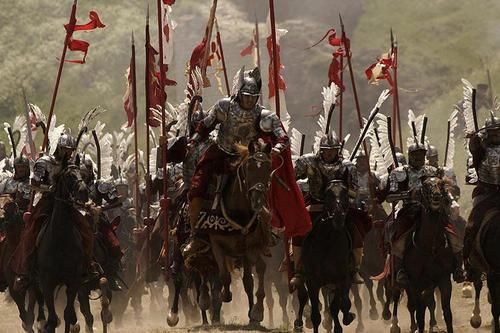
 Late last night I watched a very interesting series of videos about Winged hussars, their equipment and tactics. The videos were in Polish but I figured I could share what I learned in English, there were a couple of new things in the videos that aren't covered in the By Fire & Sword book - but which helped me understand and further appreciate some of the rules for weapons, and game play mechanics involved in that game!
Late last night I watched a very interesting series of videos about Winged hussars, their equipment and tactics. The videos were in Polish but I figured I could share what I learned in English, there were a couple of new things in the videos that aren't covered in the By Fire & Sword book - but which helped me understand and further appreciate some of the rules for weapons, and game play mechanics involved in that game!Winged Hussar armor
The armor was made up of a breastplate, shoulder guards, lobster helmet, bracers and sometimes armor protection on the upper part of the leg (this never extended below the knee).
The helmet had a nose guard which was mounted above the helmet prior to battle, but which was removed and attached reversely so that it protected the face during combat. The nose guard was held in place with a screw, and was small enough not to limit the vision, but big enough to protect the face from horizontal sword blows. The helmet brim also helped to increase the deflection of vertical sword blows.
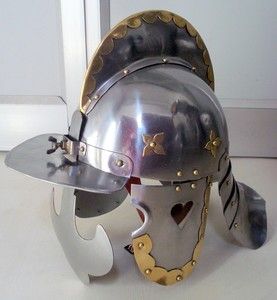 The breastplate was made out of several parts so that it could be worn comfortably when sitting atop a horse, especially at the lower part of the breastplate at the stomach area. The armor did generally not have a proper back plate but rather a smaller round metal plate(button) which (along with the shoulder armor and leather belts) served to protect the upper back. The back was also protected by animal skins, of common or exotic origin, and it served not only to appear more intimidating to the enemy but also added additional protection in close combat. The animal skin was quite difficult to cut through with sword blows ( a real animal skin such as that of a wolf was very thick and weighed around 10kg) , and as it rested atop the thick leather belts holding the breastplate and the round metal plate on the upper back it provided
The breastplate was made out of several parts so that it could be worn comfortably when sitting atop a horse, especially at the lower part of the breastplate at the stomach area. The armor did generally not have a proper back plate but rather a smaller round metal plate(button) which (along with the shoulder armor and leather belts) served to protect the upper back. The back was also protected by animal skins, of common or exotic origin, and it served not only to appear more intimidating to the enemy but also added additional protection in close combat. The animal skin was quite difficult to cut through with sword blows ( a real animal skin such as that of a wolf was very thick and weighed around 10kg) , and as it rested atop the thick leather belts holding the breastplate and the round metal plate on the upper back it provided  the Winged Hussar with ample protection.
the Winged Hussar with ample protection. Atop the breastplate the hussar also wore a gorget which protected the neck area and collar bones.
The metal parts of the full hussar armor including the helmet did not weigh more than 15kg. The thickness of the armor was about 3mm to the front and 1mm on the sides. The breastplate was bullet proof and required to pass a test with a gun at the blacksmith,
Slung over the shoulder was a metal case carrying paper tubes with pre measured amounts of gunpowder which were emptied in the pistols and other firearms the hussar would carry into battle, then from a smaller container the hussar added gunpowder for the flintlock. The effective range of a shot from a pistol was only about 5-6 meters.
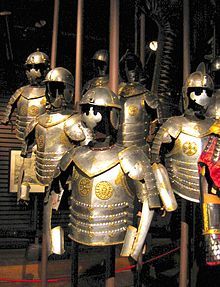 Winged hussar saber
Winged hussar saberThe Winged hussar saber was light but durable, reduction of the weight was made by making two channels in the blade. The grip came with a special guard for the thumb which not only served to protect the thumb from being cut off by a sword blow being deflected on the side of the hussar saber, but also made the grip of the sword itself tighter and reduced the risk of losing the sword in combat. The tight grip thus allowed for more fluid and advanced slashes and the sword did not turn or move around while being
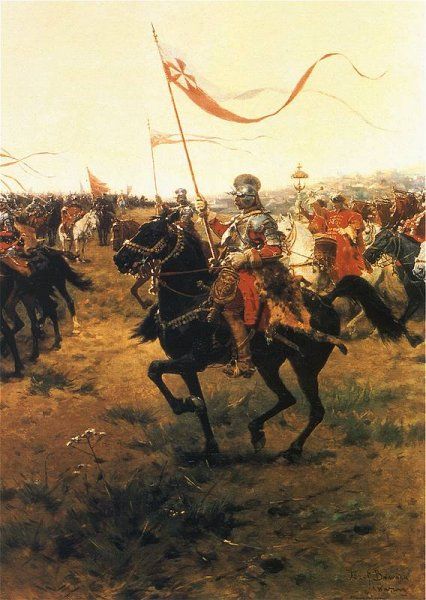 used and retained an effective angle at all times. If the saber lacked the thumb guard then the rider would wear a thick separate thumb guard.
used and retained an effective angle at all times. If the saber lacked the thumb guard then the rider would wear a thick separate thumb guard.The saber was mainly sharpened on one, but the top of the saber was also sharpened in the back which allowed for slashing both ways.
 Winged hussar lance and estoc
Winged hussar lance and estocThis was a roughly 5-6 meters long. At the tip of the lance was a pennant, which served to create a great noise when hussars charged at full speed in massed numbers. The noise from the pennants is what often is mistaken for the noise made by the wings, and was unnerving for the enemy awaiting to receive the charge.
Fastened to the saddle was a leather strap with which helped the hussar to hold and carry the lance, which though hollow was 5-6 meters long and weighed 3kg. The idea was that the hussar wasn't supposed to hold the lance in a tight grip during a charge ,but rather hold it lightly and aim it with the help of the leather strap - allowing the impetus and speed of the horse punch it into the enemy. The force from the impact of the lance did thus not hit the hussar arm but was transferred to the saddle preventing any potential arm injury of the rider. During battle it was common for the lance to impale at least two enemy infantrymen if they were standing in formation, more often than not even more were impaled by a single lance.
Once the lance had been broken from the impact it was discarded and the hussar drew his estoc which was a very long and heavy straight sword. This was used in the continuous charges and the length of this weapon was about 1.8 meters and good for punching through enemy armor. The sword was too heavy and unwieldy to be used like the saber, and was mainly used for thrusting enemy soldiers from above or when charging it was pointed at the enemy and again the saddle helped the hussar to absorb the force from the impact - the butt of the estoc was pressed against the front of the saddle. This weapon was used while the hussar horse galloped, and mainly served to impale enemy cavalry riding at the hussar from the opposite direction. This weapon was capable of puncturing any armor.
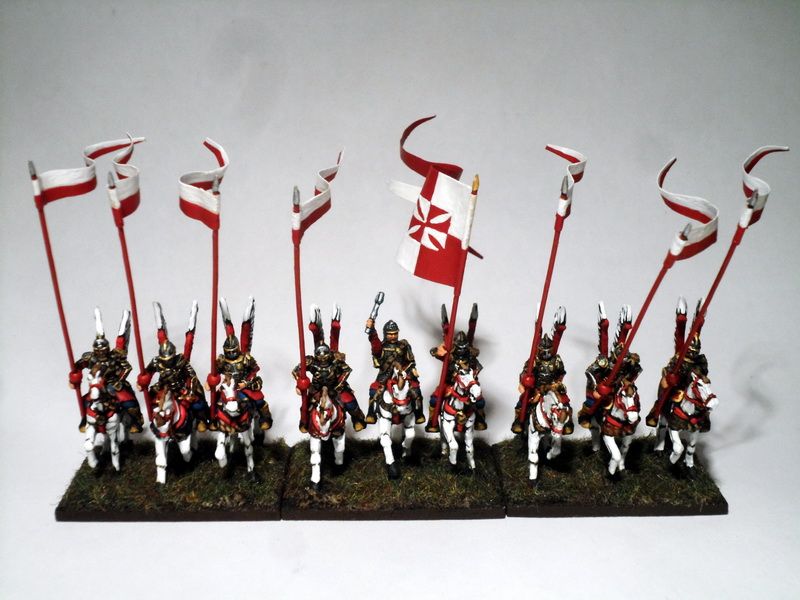
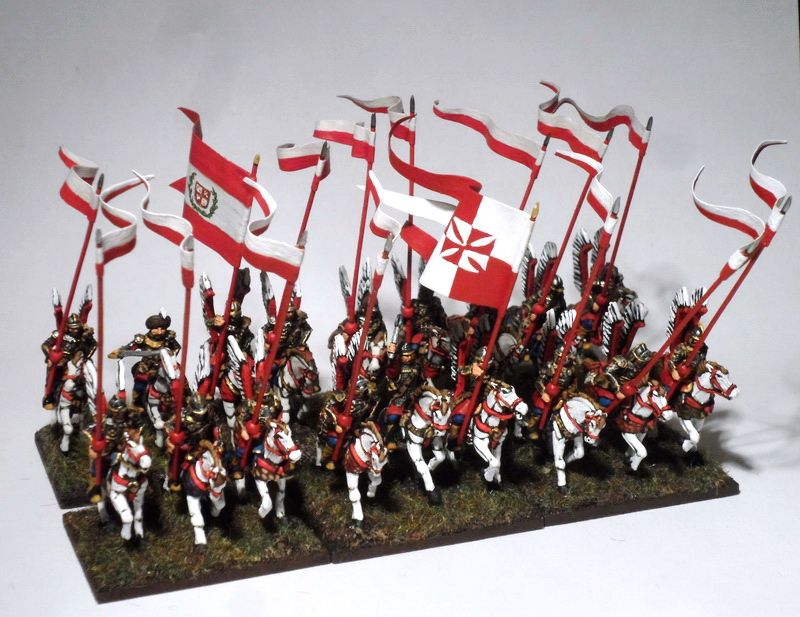
 Hussar wings
Hussar wingsThe wings of the hussar were always mounted to the back of the saddle, and it could either be a single wing or two. The wings were supposedly seldom worn into battle as they were in the way of mounting and dismounting the horse.
Hussar horses
These were not domestic but of pure blooded stock that had to be imported from Turkey or Araby. These horses were not very big but very fast and durable. However these horses matured rather late, and they stopped growing first at the age of 6, meaning most hussar horses were 7 years old before they were brought into battle. This meant that a horse such as this had to be fed and trained for 7 years, making it extremely expensive - the impressive price tag for one such horse equaled around 66kg of silver! However as the hussars were made up of nobility they could afford the cost and most hussars owned at least two horses, sometimes three or even four.
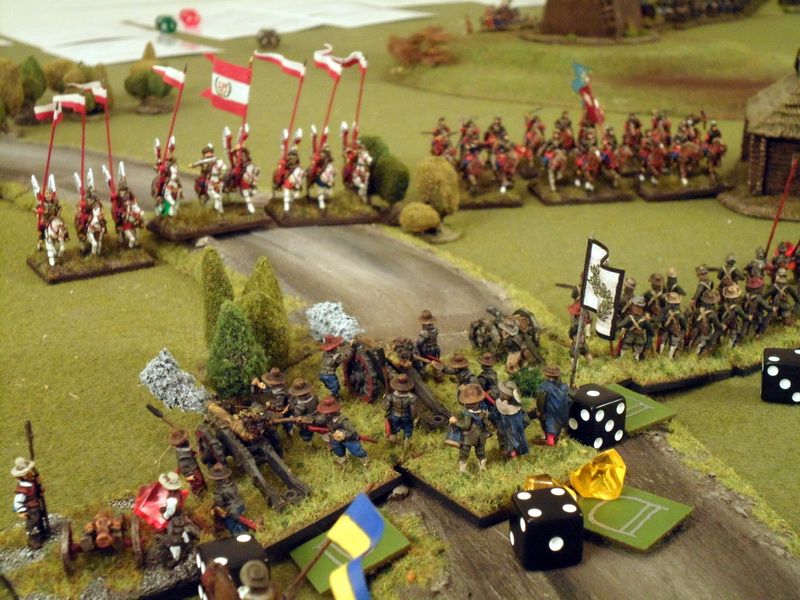 Among the training methods for the hussar horses was a small track, 1 meter wide and 25 meters long. At both ends of the track there were small 2.5meters in diameter round zones where the horse could turn around. During training the horse was raced back and forth, bringing it to a sudden halt and quickly turned around. This training made the hussar horses build up good condition and made them able to quickly perform turns and changes in direction during movement.
Among the training methods for the hussar horses was a small track, 1 meter wide and 25 meters long. At both ends of the track there were small 2.5meters in diameter round zones where the horse could turn around. During training the horse was raced back and forth, bringing it to a sudden halt and quickly turned around. This training made the hussar horses build up good condition and made them able to quickly perform turns and changes in direction during movement.The reason why a hussar needed more than one horse was simply because that horses often died in battle. Casualty ratio of riders was very low even in prolonged battles, estimated around 5% on a good day. However the horses often suffered 30% casualties.
An interesting fact is that horses at full gallop during a charge rarely stopped when hit by bullets. A horse hit by a bullet was already dying but the adrenaline and speed kept it going long enough to make the impact with the target - often infantry. This caused infantry to believe that the hussar horses were special and invincible during a charge as the horses of Reiters which either stood still or moved slowly quickly toppled over when hit by a musket. The impetus built up by a horse during a charge however had it last until impact.
Fighting infantry
The hussars fought all kinds of opponents, and adjusted their weaponry accordingly. Against tatar cavalry they did not use the lance but rather carbines and pistols. The main enemy was most often enemy infantry of Pike & Shot formations.
Enemy infantry during this period often had heavy muskets that rested on a musket fork during firing. Musketeers had to use "counter march" maneuvers to keep up a continuous rate of fire. A single musket took about 2 minutes to load, but with musketeers formed in several ranks they could cycle their ranks and fire one shot every 15-20 seconds. The weight of the musket made it hard if not impossible to fire salvos from several ranks at a time.
Oddly enough the main threat to winged hussars were not the pikemen but the musketeers themselves. The reason for this was that the winged hussar lance was longer than the pikes of pikemen during this period. More often than not the pikemen were hit before they hit the hussars charging at them, pikes during this period were often just above 3 meters long and as mentioned the hussar lance could be as long as 6 meters.
Instead most casualties came from getting gunned down durign the charge, but even this was hard for enemy infantry to do due to the weapons of the time which were highly inaccurate and ineffective at longer ranges. And while the musketeers fired their first rank the winged hussars had already closed in by around 60 meters which prevented a second line of musketeers to have time to move up and fire. Hussar charges performed at around 80 meters simply prevented enemy musketeers to efficiently use their counter march, and firing at longer ranges than 60-80 meters - something which would permit two lines to fire required was extremely ineffective. Lethality from musket fire was as such relatively low, added to the difficulty of hitting a moving target was the fact that hussars approached enemy formations in open order (only to close ranks just before the last stage of the charge).
As the hussars closed in on their enemy their ranks closed and accuracy from enemy weapons improved - but by that time the cavalry was seconds away from crashing into their opponents. Combat efficiency of hussar banners was also retained by the way they approached the enemy, doing so in lines where gaps were quickly filled by companions riding up from behind, if someone was killed or had his horse shot down from under him, in order to fill the gap.
.........
It is very interesting to see how much of this is represented in the rules of the game By Fire & Sword, both in terms of weapon profiles, special rules for infantry, movement abilities of cavalry and stats.
This makes you understand why infantry with lighter muskets able to perform a salvo where you fire with all muskets at the same time is a better option against such heavy cavalry as opposed of the heavy Spanish muskets that can only perform "counter march" (where you fire once in the defensive fire and once in the shooting after movement step).
It also gives you an idea of the reasoning behind rules such as "companions" for most of the Polish cavalry, "first strike" for hussar lances, the good armor value of the Winged hussars and why many of the Polish-Lithuanian cavalry units including the hussars have increased charge and pursuit range than that of Reiter formations.
Wednesday, May 29, 2013
The Future of National Weather Service Forecast Offices
Twenty four hours a day, every day of the year, National Weather Service forecasters are watching the weather.
They make regularly scheduled predictions.
They watch for and predict extreme weather.
At the coastal offices, there predict ocean (or Great Lake) water levels and waves. Or provide tsunami warnings after major earthquakes.
They predict streamflow and water levels of major rivers, and provide guidance for flooding situations
They forecast the dispersion of smoke from wildfires and help predict the behavior of major fires.
They determine how airports operate and who can fly.
The put out warnings when air quality deteriorates.
And much more.
In a real sense, they are the nation's environmental guardians and are a major jewel of the National Weather Service.
But local offices are in trouble: underfunded, undermanned, and underappreciated. And there are major questions regarding the role of local human forecasters in the future. This blog will examine some of these issues.
First, some background. There are roughly 120 forecast offices around the U.S. (see map). They are staffed by professional meteorologists, hydrologists, meteorological technicians, and some administrative staff. Virtually all are associated with a Doppler weather radar. And they are backed up and added by specialist colleagues at the Storm Prediction Center (SPC), the National Hurricane Center (NHC), the Aviation Weather Center (AWC) and river forecast offices (like the one in Portland).
National Weather Service meteorologists are highly trained. All have at least a B.S. in meteorology, with many possessing additional graduate degrees. In addition, the NWS has an extensive training program for all forecasters, including some wonderful computer-based modules created by the UCAR COMET program. Newly hired forecasters go through a several year internship/journeyman program before moving into lead forecast positions.
Sitting at multi-screen consoles, forecasters have sophisticated display tools for examining model output and observations, and can make their forecasts by creating graphical renditions of the expected weather.
But years of budget cuts are now having a severe toll on these public servants. With lack of funding, many NWS offices are not filling positions, with some offices down 2-3 forecasters (a few even more). Forecasters used to have research or supernumerary shifts that allowed them to improve their knowledge base, but with a lack of staff such opportunities have become far less frequent. Funding for going to conferences has been essentially eliminated, so that NWS forecasters can no longer go to relevant national conferences (like the American Meteorological Society Weather and Forecasting Conference). At our last year's NW Weather Workshop only the Seattle office forecasters could come...in previous years we would have several NWS attendees from Oregon, Idaho, and Alaska. With a lack of time of additional education and an inability to attend important meetings, forecasters lose their technical edge. And we all suffer as a result. Last year the situation got so bad, that the head of the NWS had to use creative finances to just pay salaries...and he was given the boot for doing so.
And now with the exceedingly dumb government sequester, NWS forecasters face several days of furlough, further exacerbating the situation.
It is an embarrassment for the nation that we cannot support our nation's forecasters in a reasonable way, with cuts undermining their ability to remain current or to improve their knowledge. And lack of personnel results in overworked forecasters, which clearly can degrade the quality of their work. NOAA needs to give support of our local offices more priority.
As the quality of the numerical models have improved, some NOAA bureaucrats have been hinting about a reorganization of the NWS office structure, saving money by closing offices and creating larger superoffices serving much larger areas.
My take on this: a big mistake.
A key advantage of the current structure is that the area of responsibility of each office is relatively small, thus allowing forecasters to develop an intimate knowledge of the local peculiarities of the weather of their region. This is critically important knowledge. Just as important, forecasters get to know the users of weather information in their area and can develop personal relationships with key individuals in local governments, departments of transportation, and large local businesses. Such relationships would be difficult for the staff of a distant superoffice.
As numerical weather prediction improves, NWS forecasters will need spend less time on the production of the forecasts for the next few days, but there is still plenty to do. First, there is helping local agencies, groups, and individuals understand and use weather forecasts. The new motto of the NWS is "Weather Ready Nation." That implies far more than simply making a weather forecast...it means helping users of weather information to optimally apply the forecasts. That takes a long-term relationship and lots of education regarding the strengths and weaknesses of forecasting products.
NWS forecasters need to spend more time on the achilles heal of weather prediction...the very short term period (0-3 hr). To do so they need to put more effort in nowcasting, describing what is happening now and in the next few hours.
And NWS staff require sufficient time to enhance local weather observations and to identify and fix incorrect sensors. This is particularly time consuming in this era of huge number of surface weather networks.
The students graduating programs such a mine at the UW will be filling the NWS forecaster ranks during the next few decades. Their future, and that of the NWS is bright, IF NOAA management will insure proper support of the field offices. For the last few years, lack of investment has undermined and hollowed out these crucial guardians of our safety and economic health. This needs to change.
One place to find some resources is to reform (and probably eliminate) the NWS's current inefficient and expensive region structure. The U.S. is divided into regions (e.g., the Western Region, Northeast Region, etc), each with an pricy bureaucracy headed by a high-cost administrator. Perhaps this made sense 50 years ago, but no longer. Forecasters are constantly complaining about the lack of value of the regional bureaucracy.
I am encouraged that some of our elected representatives, like Senator Maria Cantwell and the House Science Committee, having taken notice of the abysmal current situation. I hope their influence can address the poor decisions of NOAA management.
Announcement
My department is offering an introductory weather class during the summer quarter. The classes are held Tuesday through Thursday mornings during the 9-week session from June 24th through August 23rd. The course focuses on developing a basic understanding of the physical processes responsible for weather and related atmospheric phenomena. The web-site for the course is located at: http://www.atmos.washington.edu/academics/classes/2013Q3/101/
They make regularly scheduled predictions.
They watch for and predict extreme weather.
At the coastal offices, there predict ocean (or Great Lake) water levels and waves. Or provide tsunami warnings after major earthquakes.
They predict streamflow and water levels of major rivers, and provide guidance for flooding situations
They forecast the dispersion of smoke from wildfires and help predict the behavior of major fires.
They determine how airports operate and who can fly.
The put out warnings when air quality deteriorates.
And much more.
In a real sense, they are the nation's environmental guardians and are a major jewel of the National Weather Service.
But local offices are in trouble: underfunded, undermanned, and underappreciated. And there are major questions regarding the role of local human forecasters in the future. This blog will examine some of these issues.
First, some background. There are roughly 120 forecast offices around the U.S. (see map). They are staffed by professional meteorologists, hydrologists, meteorological technicians, and some administrative staff. Virtually all are associated with a Doppler weather radar. And they are backed up and added by specialist colleagues at the Storm Prediction Center (SPC), the National Hurricane Center (NHC), the Aviation Weather Center (AWC) and river forecast offices (like the one in Portland).
National Weather Service meteorologists are highly trained. All have at least a B.S. in meteorology, with many possessing additional graduate degrees. In addition, the NWS has an extensive training program for all forecasters, including some wonderful computer-based modules created by the UCAR COMET program. Newly hired forecasters go through a several year internship/journeyman program before moving into lead forecast positions.
Sitting at multi-screen consoles, forecasters have sophisticated display tools for examining model output and observations, and can make their forecasts by creating graphical renditions of the expected weather.
But years of budget cuts are now having a severe toll on these public servants. With lack of funding, many NWS offices are not filling positions, with some offices down 2-3 forecasters (a few even more). Forecasters used to have research or supernumerary shifts that allowed them to improve their knowledge base, but with a lack of staff such opportunities have become far less frequent. Funding for going to conferences has been essentially eliminated, so that NWS forecasters can no longer go to relevant national conferences (like the American Meteorological Society Weather and Forecasting Conference). At our last year's NW Weather Workshop only the Seattle office forecasters could come...in previous years we would have several NWS attendees from Oregon, Idaho, and Alaska. With a lack of time of additional education and an inability to attend important meetings, forecasters lose their technical edge. And we all suffer as a result. Last year the situation got so bad, that the head of the NWS had to use creative finances to just pay salaries...and he was given the boot for doing so.
And now with the exceedingly dumb government sequester, NWS forecasters face several days of furlough, further exacerbating the situation.
It is an embarrassment for the nation that we cannot support our nation's forecasters in a reasonable way, with cuts undermining their ability to remain current or to improve their knowledge. And lack of personnel results in overworked forecasters, which clearly can degrade the quality of their work. NOAA needs to give support of our local offices more priority.
As the quality of the numerical models have improved, some NOAA bureaucrats have been hinting about a reorganization of the NWS office structure, saving money by closing offices and creating larger superoffices serving much larger areas.
My take on this: a big mistake.
A key advantage of the current structure is that the area of responsibility of each office is relatively small, thus allowing forecasters to develop an intimate knowledge of the local peculiarities of the weather of their region. This is critically important knowledge. Just as important, forecasters get to know the users of weather information in their area and can develop personal relationships with key individuals in local governments, departments of transportation, and large local businesses. Such relationships would be difficult for the staff of a distant superoffice.
As numerical weather prediction improves, NWS forecasters will need spend less time on the production of the forecasts for the next few days, but there is still plenty to do. First, there is helping local agencies, groups, and individuals understand and use weather forecasts. The new motto of the NWS is "Weather Ready Nation." That implies far more than simply making a weather forecast...it means helping users of weather information to optimally apply the forecasts. That takes a long-term relationship and lots of education regarding the strengths and weaknesses of forecasting products.
NWS forecasters need to spend more time on the achilles heal of weather prediction...the very short term period (0-3 hr). To do so they need to put more effort in nowcasting, describing what is happening now and in the next few hours.
And NWS staff require sufficient time to enhance local weather observations and to identify and fix incorrect sensors. This is particularly time consuming in this era of huge number of surface weather networks.
The students graduating programs such a mine at the UW will be filling the NWS forecaster ranks during the next few decades. Their future, and that of the NWS is bright, IF NOAA management will insure proper support of the field offices. For the last few years, lack of investment has undermined and hollowed out these crucial guardians of our safety and economic health. This needs to change.
One place to find some resources is to reform (and probably eliminate) the NWS's current inefficient and expensive region structure. The U.S. is divided into regions (e.g., the Western Region, Northeast Region, etc), each with an pricy bureaucracy headed by a high-cost administrator. Perhaps this made sense 50 years ago, but no longer. Forecasters are constantly complaining about the lack of value of the regional bureaucracy.
I am encouraged that some of our elected representatives, like Senator Maria Cantwell and the House Science Committee, having taken notice of the abysmal current situation. I hope their influence can address the poor decisions of NOAA management.
Announcement
My department is offering an introductory weather class during the summer quarter. The classes are held Tuesday through Thursday mornings during the 9-week session from June 24th through August 23rd. The course focuses on developing a basic understanding of the physical processes responsible for weather and related atmospheric phenomena. The web-site for the course is located at: http://www.atmos.washington.edu/academics/classes/2013Q3/101/
Subscribe to:
Posts (Atom)


